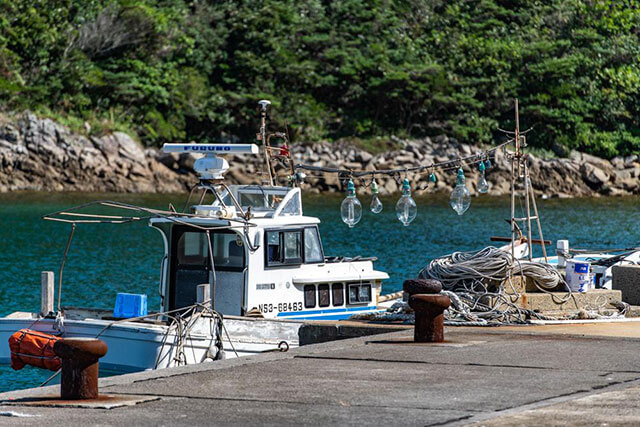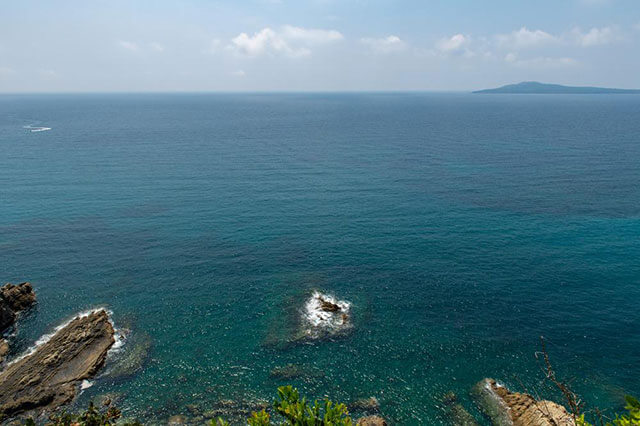
Like much of Japan, the Goto Islands are intimately linked to the oceans. For centuries, the East China Sea nurtured the peoples that made their homes on the archipelago. The hilly and rocky interiors of the inhabited islands in the chain never gave up a harvest as bountiful as the one that the seas provided.
-
![]()
The maritime history of Japan stretches back to the Yamato period when the kingdom forged links with the Southern Song Dynasty and the Three Kingdoms of Korea, bringing in an infusion of foreign expertise and culture; and Japanese history is intimately twisted up with the history of its sailors’ adventures on the high seas. The Goto Islands are part of that history, as well; it was from the Goto Islands that Kukai departed in the 9th century for a tour of China, and this was the final stopover for the envoy ships heading to the Tang Empire.
![]()
At Naru Island’s Egami Church, a church built by formerly clandestine Christians that made a living as fishermen, the seashells that decorate many surfaces are a testament to the importance of the sea. Condemned to be fishermen rather than fishers of men, the kakure—hidden—Christians escaped to the islands centuries before these churches were once again allowed to be built. The East China Sea provided a natural barrier between religious persecution back on the Home Islands, and the fishermen went out into the waves to feed the people.
- Egami Church
-
-
- Nagasaki Pref. Gotoushi Narumachiokushi 1131-2
-
-
-
- [Tour registrationHours]9:00…
-
View All![]()
And what a fine metaphor this is: at Dozaki Church on Fukue Island, holy water is held in a seashell font. When the missionaries finally returned, they found the kakure Christians practicing their own religion, a merging of folk beliefs and Catholicism. On the islands, the kakure adopted the beliefs and superstitions of the fishermen, observing the taboos of the fishing villages, and quietly making similar pilgrimages to remote hokora to make offerings to ensure the safety of the men that fed the community with their dangerous voyages out onto the open seas.
- Dozaki Church
-
-
- Nagasaki Goto-shi Okuuracho Dozaki 2019
-
-
-
- 0958530053
-
-
-
- 9:00-17:00
-
View All![]()
Looking out from Takahama on Fukue Island, the Gyoran Kannon watches the waves. And did those hidden Christians of the Goto Islands see the syncretic possibilities of the Gyoran Kannon? They must have, for they often reworked the already durable Avalokitesvara into an avatar of Mary—but the Gyoran Kannon, with her basket of fish, probably an import from devout Fujianese that fished the same waters, suggests other parallels: Christ, who stilled the stormy waters and rebuked the wind, and Christ, who fed the multitudes from a basket of two fishes.
- Ikitsuki Daigyoran Kannon
-
3.0
14 Reviews -
-
- Nagasaki Hirado-shi Ikitsukicho Yamadamen 570-1
-
-
-
- 0950531113
-
-
-
- [Tour inside the pedestal] […
-
View All![]()
The bounty of the East China Sea kept the islanders alive for centuries. The thick forests and hilly scrubland of the island pushed the villages down to the sea, where the fishermen landed their catch. The cuisine of the island was defined by the East China Sea, as well. The menus at local restaurants now tend to more luxurious items than the fishermen would have eaten but a simple bowl of udon in dashi is perhaps more representative. And the ocean is in that bowl, too, not only in the dashi but in the hit of flaky sea salt that has become one of the island’s famous exports.
![]()
Up in Shinkamigoto, a territory which covers the two northernmost islands of Nakadori and Wakamatsu, it was whaling that paid the bills. In Arikawa, up on the northeastern lobe of Nakadori, a shrine to the great creatures of the ocean that supported the people of the community. Down at Arikawa’s ferry terminal, a museum to the old trade has been set up. The whaling guilds have erected shrines and memorials to the whales, and they can be found dotted across the Goto Islands.
- Kaido Shrine
-
-
- Nagasaki Minamimatsuura-gun Shinkamigoto Cho Arikawago
-
-
-
- 0959524964
-
View All![]()
The fishermen, whalers, the villagers, the kakure Christians—they survived centuries of hardship on these islands, but their way of life has been slowly disappearing. Life is easier on the Goto Islands, and the tourists arrive to visit the beaches, and maybe head out on a local launch to fish tuna. The guilds have faded as commercial whaling has fallen by the wayside, and more people come on whale watching tours, now. The tuna farms off the coat provide fresh bluefin to big city sushi-ya are a sign of changes on the island, too. The ocean still pays the bills, but things are different, now.
![]()
The fishermen and the kakure survived centuries of hardship on their islands, but their way of life has been slowly disappearing. Life is easier on the Goto Islands, and the tourists arrive to visit the beaches, and maybe head out on a local launch to fish tuna. The tuna farms that provide fresh bluefin to Ginza sushi-ya are a sign of changes on the island, perhaps; the ocean still pays the bills, but things are easier now.



 Go here
Go here














